Part of a series of posts for Brain Awareness Week, March 12-16.
The structure of the brain is beautiful, an enormous web of interwoven neurons that constantly fire thoughts back and forth in crackles of bioelectrical impulses. But although we can map the physical structure, no one has been able to observe a living, thinking brain building itself. So we don’t know how neurons self-organize to create their web – or why they sometimes fail to, as in certain kinds of mental illness and intellectual deficits.
Instead of grappling with the brain’s complexity, UConn Health assistant professor of pediatrics and biomedical engineer Min Tang-Schomer wondered if she could create a simple, single brain circuit from scratch. Tang-Schomer, who also has a joint appointment as research scientist at the Jackson Laboratory for Genomic Medicine, began growing neurons in a dish. Even just a few neurons in a dish are beautiful.
“They look like the cosmos,” she says. And when she attached a few electrodes to the cells and began to send them electrical signals, the cells responded. With a couple of electrodes and some experimenting, she was able to make the neurons pulse in synchrony. It’s a sign they’re wired together in a functional way.
Min-Tang Schomer hopes insights from her neurons in a dish could ultimately be used to help and heal people who don’t have the normal connections between neurons that a healthy brain takes for granted.
The electrodes might seem artificial, but the electrical signal, after being converted to a chemical signal, is the natural way our neurons talk to each other. When a photon hits a receptor in your eye, the receptor flashes a pulse of electrical signal through your optical nerve that tells your brain ‘purple’. When you brush your hand along a stove, the nerves send an electrical impulse to your brain that screams ‘hot!’ That’s how a baby’s brain learns to organize itself. The sight of a flame quickly gets linked to the feeling of pain the first time a toddler reaches for a lit candle. Over time, the functional associations of different parts of the brain get reinforced into stronger and thicker nerve connections. Connections less frequently used might disappear.
In a dish, Tang-Schomer’s lab wants to re-create the process with neurons, electrodes, and some experimenting. Previously she has fabricated an artificial circuit with paved “highways” for the nerve bundles, called axons. Now she plans to connect this circuit to the synchronization program she just found, and explore how the neurons adapt. She has also tried different pulsing programs to direct the growth of nerve connections in three dimensions, work she recently published in Brain Research. Combining all these technologies, Tang-Schomer hopes that one day, we can not only observe how the brain grows in a dish, but also play with an artificial mind.
No one knows what Tang-Schomer’s neurons in a dish are thinking about, if you can even call the pulsing of a single circuit of neurons in a dish a ‘thought’. But she hopes that these simple circuits will lead to more complex circuits, and a better understanding of how neurons organize into brains. Eventually she hopes insights from her neurons in a dish could be used to help and heal people who don’t have the normal connections between neurons that a healthy brain takes for granted.
Read more about UConn research on the brain in the series Brainstorm.



